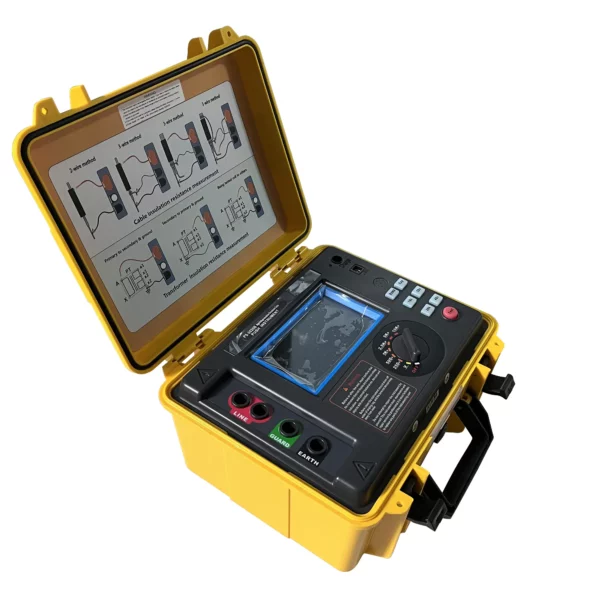Megger Tests are an essential part of acceptance testing for electrical installations, ensuring that the installation meets safety and performance standards.
Here’s how Megger Tests are used in acceptance testing for electrical installations:
- Safety Verification: Megger Tests are conducted to verify that the insulation of electrical conductors and components is in good condition and safe for operation. This is especially important for new installations to ensure that insulation has not been damaged during the installation process.
- Insulation Resistance Measurement: Megger Tests measure the insulation resistance of the electrical components and wiring in the installation. The tester applies a high DC voltage to assess the resistance to current flow through the insulation. The results are typically provided in ohms (Ω).
- Acceptance Criteria: Acceptance criteria for insulation resistance vary depending on the specific installation, local regulations, and industry standards. Electrical codes often define the minimum acceptable insulation resistance values for various types of installations.
- Compliance with Standards: Acceptance testing ensures that the installation complies with relevant electrical codes and standards, such as the National Electrical Code (NEC) in the United States or the International Electrotechnical Commission (IEC) standards in other regions.
- Documentation: The results of Megger Tests are documented as part of the acceptance testing process. Test reports should include details about the tested components, the test conditions, and the measured insulation resistance values.
- Equipment Checks: Megger Tests are not limited to insulation resistance measurement. They can also be used to test the insulation of individual components such as cables, motors, transformers, and other electrical equipment. This ensures that all components within the installation meet safety and performance requirements.
- Troubleshooting: If Megger Tests reveal low insulation resistance values, acceptance testing may include troubleshooting to identify and rectify any issues in the installation. Common problems such as moisture ingress, damaged insulation, or improper installation can be addressed.
- Safety Certification: Once the installation passes the Megger Tests and meets all relevant criteria, it can be certified as safe and compliant. This certification is often required before an electrical installation can be put into service.
- Verification of Installation Quality: Megger Tests help verify the quality of the installation workmanship and the effectiveness of insulation materials used. Acceptance testing identifies potential defects that may have occurred during the installation process.
- Preventive Maintenance Planning: The results of Megger Tests obtained during acceptance testing can serve as baseline data for future maintenance and testing. This information can help in planning preventive maintenance to ensure the continued safety and reliability of the electrical installation.
In summary, Megger Tests in acceptance testing for electrical installations are crucial for confirming that the installation meets safety and performance standards. They provide valuable data for certification and serve as a foundation for ongoing maintenance and troubleshooting efforts. The acceptance testing process ensures that the electrical installation is safe and complies with relevant electrical codes and standards.
What safety precautions should be followed when using a Megger Tester?
Safety is a top priority when using a Megger Tester, as it involves applying high voltage to electrical systems. Adhering to proper safety precautions is essential to prevent accidents and ensure the well-being of the personnel conducting the tests.
Here are important safety precautions to follow when using a Megger Tester:
- Training and Qualifications:
- Ensure that individuals using the Megger Tester are properly trained, qualified, and knowledgeable about its operation and the associated risks.
- Personal Protective Equipment (PPE):
- Wear appropriate PPE, which may include insulating gloves, safety glasses, and protective clothing, to protect against electrical hazards.
- Equipment Inspection:
- Before each use, visually inspect the Megger Tester for any signs of damage, wear, or defects. Ensure that cables, connectors, and the tester itself are in good condition.
- Grounding:
- Ensure that the equipment being tested is properly grounded to prevent electrical accidents and ensure the safety of personnel.
- Safe Test Environment:
- Conduct tests in a well-ventilated, controlled environment that is free from potential electrical hazards, megger tester such as water or conductive materials. Remove any flammable materials from the area.
- Risk Assessment:
- Perform a risk assessment before the test to identify potential hazards and develop a safety plan to mitigate them.
- De-Energization:
- Ensure that the equipment being tested is de-energized and disconnected from the power source before conducting Megger Tests. Follow proper lockout/tagout procedures.
- Discharge Equipment:
- After completing the test, discharge any stored energy in the equipment under test to prevent accidental discharges or electrical shocks during disconnection.
- Proper Test Setup:
- Follow the manufacturer’s instructions for setting up the Megger Tester and connecting it to the equipment. Ensure that all connections are secure.
- Safe Test Voltage:
- Use the appropriate test voltage based on the equipment and insulation being tested. Excessive voltage can lead to insulation breakdown.
- Test Sequence:
- Establish a test sequence that minimizes the risk of personnel exposure to high voltage. Start with a low voltage and increase it gradually.
- Monitoring:
- Continuously monitor the test equipment and the test environment during the test to detect any anomalies or safety concerns.
- Emergency Procedures:
- Develop and communicate clear emergency procedures for handling accidents, electrical faults, or unexpected events. Personnel should know how to respond in case of an emergency.
- Safety Barriers:
- Use safety barriers, warning signs, and controlled access to establish a safe zone around the testing area to prevent unauthorized access.
- Calibration and Maintenance:
- Regularly calibrate and maintain the Megger Tester according to the manufacturer’s recommendations to ensure its accuracy and reliability.
- Knowledge Sharing:
- Share knowledge of the potential electrical hazards and safety procedures with all personnel involved in the testing process.
Compliance with these safety precautions is essential for conducting Megger Tests safely and effectively. It is crucial to protect personnel, prevent electrical accidents, and ensure the reliable assessment of insulation resistance in electrical systems and equipment.
